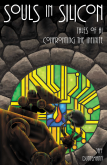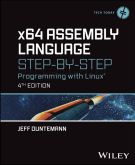In other words: It’s done. Well, at least the hardest part (for me) is done: Yesterday I uploaded the last odd bits of x64 Assembly Language Step by Step, Fourth Edition to the publisher’s cloud. Now comes the work that I don’t have to do: copy edits, tech edits, layout, proofing. I will have some odds and ends to deal with down the road a ways, like looking at the proofs, building the listings archive, and rewriting my assembly book web page to reflect the new edition.
The publisher hired the estimable David Stafford to do tech edits, which is quite an honor. I’ve known David since the early PC Techniques days, and that guy knows his stuff with a capital-K. If there are booboos, bugs, or dryer lint in that thing, he’ll spot it. (Dryer lint we may leave for the production service.)
I’ve been working on this project since mid-April 2022. This is the fourth edition of the book from John WIley, and the fifth edition overall. The very first edition came from Scott, Foresman at the end of 1989, and was part of a short-lived assembly language series that I acquired and edited for them on contract back in the very late ‘80s. Its original title was Assembly Language from Square One. We were just getting out of second gear in 1990 when Scott Foresman was sold to Harper Collins. Toward the end of 1990, Harper Collins put the Scott Foresman trade book line out of print. I got the rights back in 1991.
I turned around and took the book to John Wiley, who bought it on the spot. I rewrote and expanded the book, which appeared from Wiley in 1992. The title had to change when I took it to Wiley to avoid mixups on retail channel returns, so the book became Assembly Language Step-by-Step. That’s not a bad title, in fact, since the whole point of the book was to do a methodical, patient introduction for people just getting started in computing. The 1992 edition was all-DOS, as you might imagine. In 1999 Wiley asked me to do an update that included both DOS and 32-bit Linux. I retained nearly all of what had been in the first Wiley edition, and added another 200 pages for 32-bit concepts and Linux. It was published in 2000.
That book sold extremely well for its nine-year life. In 2008 Wiley asked me for a new edition devoted entirely to Linux. DOS was almost extinct by then, so it was a good move. With only one tail to wag I was able to go into a great deal more detail about Linux and 32-bit protected-mode programming generally. It was a big job that took me seven or eight months, but the book appeared in 2009, at 610 pages.
As the teens drew toward the 20s and 64-bit Intel/AMD CPUs went mainstream, I enquired about a 64-bit edition every so often. In each case, my acquisitions editor basically said, “Don’t call us. We’ll call you.” So I stopped asking, and the 2009 edition kept on selling.
The call came in early April 2022. My old acquisitions editor had retired, and the new one was very much on board with an x64 rewrite. He asked me how long it would take. By then I was 69, and asked, How about a year? He said, Sure.
And that’s almost what it took, whew.
I don’t exactly when we’ll have books. Summer, I’m guessing; maybe late summer. It’s hard to know in this business. I’ve already been asked if I’m ever going to do a 128-bit version. Well, we need 128-bit CPUs first, and in truth I don’t see them on the horizon. We needed 64 bits for the address space way more than the register width. Since the AVX-512 math subsystem on nearly all modern Intel/AMD CPUs already has 512-bit registers, we don’t need the register width, and since 264 is 1.84 x 1019, we’ve already got all the address space we will ever need. Without 128-bit Intel/AMD CPUs, my guess is that the fourth edition of the book will be the last, and it could well be around long after I go on to other realms.
If I’m going to do any large-scale programming tutorials going forward, it’ll be about the Lazarus IDE and GUI builder. But at least for the coming year, if I write anything at all I’m going to write SF.
But I think you knew that.










